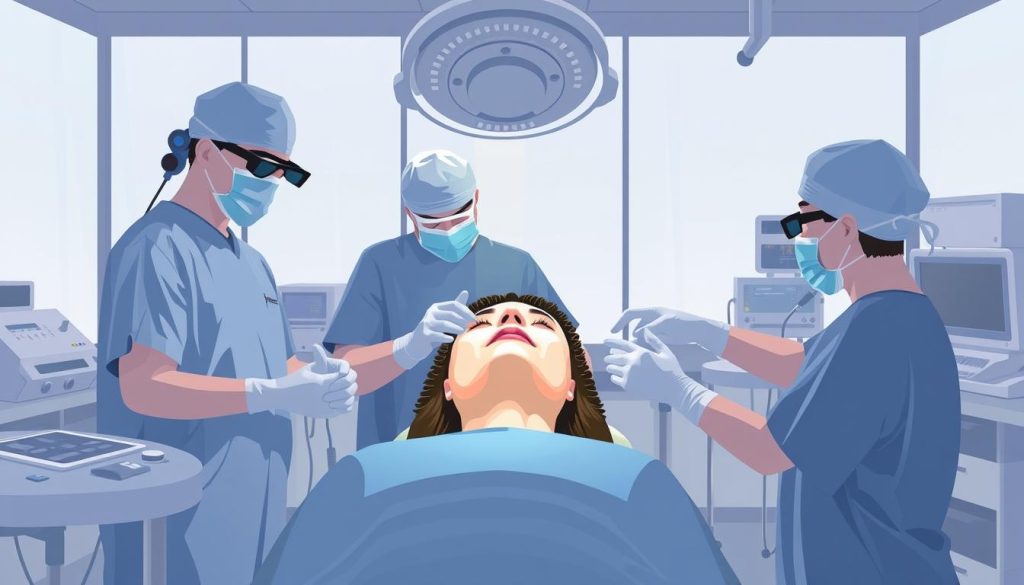Facial plastic surgery has become a popular option for individuals seeking to improve their appearance or correct facial deformities. This type of surgery is divided into two main categories: reconstructive and cosmetic.
Reconstructive procedures aim to restore normal function and appearance to the face, often addressing conditions present from birth or resulting from injury. Cosmetic facial plastic surgery, on the other hand, focuses on enhancing the visual appeal of facial features.
Modern techniques in facial plastic surgery have significantly improved, offering more natural-looking results and shorter recovery times. Patients can now choose from a range of options and treatments tailored to their needs.
Key Takeaways
- Facial plastic surgery includes both reconstructive and cosmetic procedures.
- Reconstructive surgery corrects facial deformities and restores function.
- Cosmetic facial plastic surgery enhances the appearance of facial features.
- Modern techniques offer natural-looking results with shorter recovery times.
- Patients have various options and treatments available.
What is Facial Plastic Surgery?
Facial plastic surgery is a medical specialty that focuses on enhancing or restoring the appearance and function of facial structures. It encompasses a range of procedures, from reconstructive surgeries that address congenital abnormalities or trauma injuries, to cosmetic procedures aimed at enhancing aesthetic appearance.

Reconstructive vs. Cosmetic Procedures
Facial plastic surgery is divided into two main categories: reconstructive and cosmetic procedures. Reconstructive procedures are necessary to treat existing conditions such as skin cancer, trauma, or congenital defects, focusing on restoring normal function and appearance. In contrast, cosmetic procedures are elective surgeries that aim to enhance the aesthetic appeal of facial features, addressing signs of aging or improving facial proportions and symmetry.
Who Performs Facial Plastic Surgery
Board-certified plastic surgeons and facial plastic surgeons, often with backgrounds in ENT/otolaryngology, are the primary specialists who perform facial plastic surgery procedures. These surgeons undergo extensive training in both the functional and aesthetic aspects of facial anatomy, ensuring a high level of expertise and safety in their practice.
Popular Plastic Surgery Face Procedures
Several popular plastic surgery face procedures can address various concerns, from aging to facial harmony. These procedures are designed to restore or enhance the appearance of the face and neck, offering individuals a more youthful and refreshed look.

Rhytidectomy (Facelift)
A facelift, or rhytidectomy, is a surgical procedure that improves visible signs of aging in the face and neck. It addresses relaxation of the skin causing sagging, deepening fold lines, and excess fat. Modern facelift techniques focus on natural-looking results.
Rhinoplasty and Facial Implants
Rhinoplasty is surgery of the outside and inside nose to improve appearance and function. Facial implants, particularly for the chin and cheeks, can create better facial balance by augmenting areas that lack projection or volume.
Eyelid Surgery and Brow Lifts
Blepharoplasty (eyelid surgery) removes excess skin and fat from the upper and/or lower eyelids, addressing both cosmetic concerns and functional issues. A brow lift elevates sagging eyebrows and reduces forehead wrinkles, opening up the eye area.
Benefits of Facial Plastic Surgery
Facial plastic surgery offers numerous benefits that can significantly enhance a patient’s overall appearance and quality of life. These benefits can be broadly categorized into aesthetic improvements and functional enhancements.
Aesthetic Improvements
Aesthetic improvements through facial plastic surgery include restoring a more youthful appearance by addressing signs of aging such as sagging skin, wrinkles, and volume loss in the face and neck. Procedures like facelifts, brow lifts, and eyelid surgery can enhance facial harmony and balance, creating a more aesthetically pleasing appearance. For instance, a facelift can improve visible signs of aging, while otoplasty can reshape the cartilage of the ears to reduce their protrusion.
- Restoration of youthful contours
- Enhanced facial harmony and balance
- Correction of prominent features like a large nose or protruding ears
Functional Enhancements
Functional enhancements address medical issues that impact daily life, such as breathing difficulties corrected through rhinoplasty or vision problems improved through eyelid surgery. Reconstructive procedures can restore normal appearance and function following trauma, cancer surgery, or congenital abnormalities. These functional improvements can significantly enhance a patient’s quality of life and self-confidence.

What to Expect: Recovery and Results
As patients navigate the process of facial plastic surgery, the recovery period is a critical component of achieving optimal results. Most facial plastic surgery procedures are performed on an outpatient basis, allowing patients to return home the same day. However, the recovery process can vary significantly depending on the specific procedure and individual patient factors.
Patients should expect some degree of swelling, bruising, and discomfort in the days following surgery. These effects gradually subside over the first two weeks. Surgeons provide detailed post-operative care instructions, including wound care, activity restrictions, and medication guidelines to optimize healing and results.
The removal of sutures typically occurs 5-7 days after surgery, with follow-up appointments scheduled to monitor healing progress. Most patients can return to work and light social activities within 1-2 weeks. Full results may not be apparent immediately, as residual swelling can take several months to completely resolve, particularly with procedures like rhinoplasty.
To maintain the benefits of facial plastic surgery, patients should prioritize proper skin care, sun protection, and healthy lifestyle choices. Selecting a board-certified plastic surgeon with specific expertise in facial procedures is crucial for achieving optimal safety and aesthetic outcomes.
FAQ
What is the difference between a facelift and a neck lift?
A facelift is a procedure that targets the lower two-thirds of the facial area, while a neck lift focuses on rejuvenating the neck and jawline. Both procedures can be performed together to achieve a more comprehensive facial rejuvenation.
Are facial fillers a permanent solution?
No, facial fillers are not permanent. They are made of various materials, such as hyaluronic acid or calcium hydroxylapatite, and typically last between 6 to 24 months, depending on the type and individual factors.
Can I undergo rhinoplasty if I have a deviated septum?
Yes, rhinoplasty can be performed to correct a deviated septum, which can improve breathing and overall nasal function. This procedure is often combined with cosmetic rhinoplasty to enhance the appearance of the nose.
What is the recovery time for eyelid surgery?
The recovery time for eyelid surgery, also known as blepharoplasty, typically ranges from 1 to 2 weeks. Patients may experience bruising, swelling, and dryness, which can be managed with medication and proper post-operative care.
Are liposuction and fat transfer procedures safe?
Yes, when performed by a qualified and experienced surgeon, liposuction and fat transfer procedures are generally safe. However, as with any surgical procedure, there are risks and potential complications, such as infection or scarring.
Can facial implants be removed or revised?
Yes, facial implants can be removed or revised if necessary. This may be due to various reasons, such as implant displacement, infection, or patient dissatisfaction with the results.
How long do the results of a brow lift last?
The results of a brow lift can last for several years, depending on individual factors, such as skin elasticity and aging. On average, the effects of a brow lift can last between 5 to 10 years.
